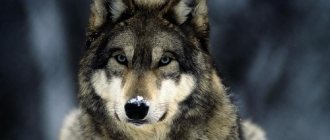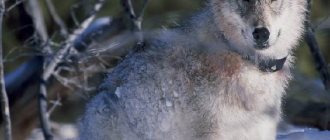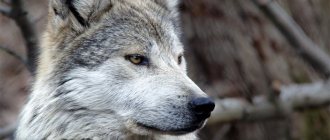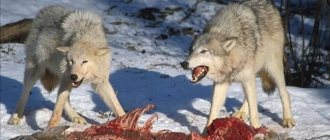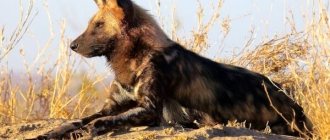- Wild animals
- >>
- Mammals
The tundra wolf is a predator of the canine family, belonging to the genus of wolves, one of its subspecies, living in northern Russia. The Latin name is Canis lupus albus and was characterized in 1872 by Arthur Kerr. It was also described by Ognev in 1929 as the Turukhan wolf (turuchanesicus); Dobovsky in 1922, as the Kamchatka (kamtschaticus) wolf; Dubovsky in 1922 as Dubovsky's wolf in 1929
Origin of the species and description
Photo: Tundra wolf
The wolf has many subspecies (some zoologists identify up to 25), but external differences are erased. Predators can be clearly divided into three large groups: tundra, forest and desert-steppe individuals. They all have common ancestors. It is believed that tundra predators are much larger than other subspecies, but this is not so. The fluffy fur that protects wolves creates a large volume, which is what makes the animals look especially large.
This animal is adapted to harsh arctic conditions. There are very few differences between the inhabitants of the tundras of the European part of Russia, Western Siberia, Taimyr, and Yakutia. They are similar in appearance and lifestyle to predators living in Alaska and the Canadian tundra. Most often, animals can be found in the open landscapes of the southern tundra and forest-tundra. Within these zones, placement within the territory depends on the availability of food resources—ungulates, the possibility of hunting them, and the depth and quality of the snow cover.
Video: Tundra wolf
Tundra wolves are pack animals, but we can talk about a group as a single whole if there are strong relationships between members of the community and they act together. The core is the mature couple. The male is the leader in matters of display of force, and his partner determines the route of the pack. When dispersed, young people always know where the she-wolf is by howling and marks. Adult low-ranking predators, together with the mature pair, form the core of the pack and control the behavior of the remaining members, dampen their aggressiveness and maintain the structure.
Sexually mature individuals of lower rank, under strict control, leave the pack, live alone or unite in a group. One-year-old or newly arrived individuals have a spare status. They are energetic and inquisitive, they are the first to learn and convey to the flock information about the future victim of the hunt.
Life in a pack
It has long been known that the wolf is a social animal. He lives only in a pack. Typically, this is a family group of seven to twenty individuals. It is led by a male and a female. All the rest are cubs and grown-up young wolves who remained in the pack from previous litters. Sometimes a lone wolf may join the pack, but he strictly obeys the leaders.
Giving birth to puppies in a pack is the priority right of the female leader. The cubs of other females are destroyed immediately. The polar wolf of the tundra adheres to such harsh laws - it is difficult to feed a large number of mouths.
The survival of a pack depends on how large its hunting grounds are. That is why they fight to the death for their territory. This territory can be from fifty to one thousand five hundred square kilometers.
Appearance and features
Photo: What a tundra wolf looks like
The tundra wolf is a fairly large predator; the average parameters for a male in the Arkhangelsk region are:
- body - 118-137 cm;
- tail – 42-52 cm;
- skull -25-27 cm;
- weight – 40-43 kg.
The female is characterized by the following indicators:
- body – 112-136 cm;
- tail – 41-49 cm;
- skull – 23.5-25.6 cm;
- weight – 36-37 kg.
In Taimyr there are larger individuals, whose body length is 123-146 cm and weight 46-48 kg; there are wolves up to 52 kg. The animal has thick and long hair. It feels soft and fluffy to the touch.
The lengths of the hairs are:
- guides - 15-16 cm;
- guard - 8-15 cm;
- underfur – 7 cm.
The tundra subspecies is much lighter in color than the forest subspecies, light gray with a reddish-gray underfur above and lead-gray below. Shades vary from bluish-gray (in young people) to reddish-gray (in old ones). Old individuals also have a lighter color. At the beginning of winter, the animals are darker in color, and in the spring they fade and become lighter. There are no almost white animals, as in the far north of North America. In coloration, animals from the Kola Peninsula and the extreme northeast of Siberia are more similar to their forest counterparts.
The feet are well covered with strong hair between the toes. This increases the support area, which is important when moving on snow. The powerful paws are gathered into a ball, the epithelium on the pads is keratinized. The forelimbs are rounded, the hind limbs are oval. When running, the hind paws step on the footprints of the front paws, and an even chain of footprints is visible in the snow. When the cover is deep, the flock follows exactly the same trail, so that it is impossible to understand how many animals have passed.
Where does the tundra wolf live?
Photo: Tundra wolf in Russia
This subspecies of wolf is rare on the Kola Peninsula. In Karelia it prefers places where people live, sparse forests and along the shores of the White Sea. In the tundra and forest-tundra of the European part of Russia, wolves make seasonal migrations. In summer they move to the tundra, and in winter to the border with the forest-tundra.
On the Kanin Peninsula, tundra predators are found all year round. The main population of the European part and wolves from the Timan tundra winter in the Czech Bay area. In summer, they completely leave these places and their burrows can already be found along the rivers Wolonga, Travyanka, Shchuchaya, Indiga, Belaya, Svetlaya, Kamennaya Viska, Velti, Neruta, Sula.
Individuals living in the Timan and Malozemelnaya tundra migrate to the Timan ridge and do not appear on the coast. In summer, tundra wolves make burrows in the west of the Bolshezemelskaya tundra, along the upper reaches of the Adzva, Bolshaya Rogovaya, Chernaya, Korotayka, Silovaya, Kara rivers, along the Pai-Khoi ridge. In winter, they move to the forest-tundra from the Pechora bend to the upper reaches of the Usa. Some of them go beyond the Ural Mountains.
In the Urals and the Yamalo-Nenets Autonomous Okrug, these predators are numerous in the tundra, but they make dens for the most part in the southern zone of the tundra and forest-tundra. In the Arctic tundra, the wolf is rare, as it stays closer to human habitats and herds of domestic reindeer. There are many wolves in the southern part of the tundra of Western Siberia, especially in the northeast, where wild and domestic reindeer live. Predators can be found at the mouth of the Yenisei, in the lower reaches of Olenek, Yana, and Lena.
In the Verkhoyansk region, Kolyma and Chukotka, gray predators are a common sight. They are also found on the Lyakhovsky Islands, but only in summer, and in winter, following the herds of deer, they migrate to the mainland. During the breeding season, den sites are well protected. Hunting grounds are varied. In the tundra, roosting sites are located mainly in river valleys, in thickets of willow and dwarf birch. In the Yamal and Bolshezemelskaya tundra, predators often make dens in bushes along river valleys or dry meadow slopes, on terraces above floodplains, and in dry willow forests along watersheds. They settle more densely on the coast.
Now you know where the tundra wolf lives. Let's see what he eats.
Habitat
Arctic wolves are common throughout much of the High Arctic, including Greenland, Alaska and Northern Canada. Their habitat is snow-covered for most of the year. These are barren polar regions. Permafrost and harsh conditions do not allow Arctic wolves to dig holes for living, shelter and giving birth to offspring. For these purposes they use caves in the rocks
What does the tundra wolf eat?
Photo: Eurasian tundra wolf
It is a predator and the basis of its diet - medium and large mammals, often ungulates. Their number determines the number of wolves. In summer, a greater variety of feed is available for medium- and small-sized animals. In the cold season, the tundra wolf's main food is wild and domestic reindeer, mostly calves and vazhenkas. Among the animals of medium size are arctic foxes, hares, foxes, and among small animals - various rodents, fish, and among birds - ptarmigan. Wolves can feed on carrion and rob traps and traps of hunters.
In summer, birds occupy a significant share of the diet: flocks of molting geese, chicks, and eggs of other migratory birds. Since, apart from Taimyr, wild reindeer are quite rare in other regions of the Far North, domestic reindeer are of great importance in the summer; herds especially suffer during calving. About 36% of deer are killed by tundra wolves in the spring and summer.
Interesting fact: A pack of 5-7 tundra wolves can drive and at one time eat a deer weighing about 120 kg. At the site of the feast, only horns, bones, and scar remain. But when wolves are opened, the stomach contents are no more than 2-3 kg, up to a maximum of 6 kg.
Food is digested very quickly. The stomach of wolves caught several hours after a heavy meal is half empty. The daily food requirement depends on the time of year and is 4-6 kg. Predators can eat for future use and hide their prey in reserve. This is especially true for the tundra wolf.
In winter, in places where livestock are kept in stalls, wolves eat everything they can get, including carrion at cattle burial grounds and even their own brothers. Hunters often observe how wolves eat predators shot from an airplane or encounter the corpses of animals killed by fellow tribesmen or a pack gnawing on the remains of a wolf.
Lifestyle
Tundra wolves live in packs of up to 20 adults. The group usually includes an adult dominant pair , as well as young individuals from the previous litter. In some cases, you can see single animals from other packs here. The latter occupy a subordinate position in an unrelated group.
In each such team there is a strict hierarchy. All animals know their social niches, and any disobedience is immediately suppressed.
Wolves have very close bonds with their pack mates. They communicate with each other using facial expressions and body movements, which helps them act together. In a pack, each animal has its own responsibilities. Someone tracks prey, and someone chases it. Young wolves under 2 years of age enjoy great position and respect in the pack.
The tundra wolf can sleep on cold stones, buried in the snow. They do not dig holes; they can only settle in already created holes of other animals.
Communication in a flock occurs using various sounds:
- Snorting - warning of danger
- Whining means friendliness and good mood
- Squealing indicates pain or fear
- Growling conveys an aggressive attitude
- A wolf of a certain status in the pack can only howl in a certain way: The leader can howl deeply and protractedly; The alpha female is more mournful and “thinner”; Young wolf cubs howl intermittently.
Like many other predatory animals, the tundra wolf represents the top of the food chain.
Apart from humans , this beast no longer has natural enemies. Young individuals are sometimes killed by bears or wolverines. However, this happens extremely rarely.
Nutrition
Taking into account the fact that the habitat of tundra wolves includes the sea coast, this imposes certain specifics on the diet. The sea often washes ashore the dead carcasses of dolphins, seals, and killer whales. All these “seafood” are eaten by predators. A wolf pack does not have a specific territory. This is especially true in winter, when she follows a herd of deer. It constantly moves in search of food, and tundra wolves follow it.
In winter , both wild and domestic deer serve as prey. Thus, in the stomachs of 74 wolves caught in the Nenets Autonomous Okrug, there were more than 93% of the remains of deer. Hares, arctic foxes, rodents and other living creatures are also eaten.
The teeth of a wolf are massive and tear and grind food with equal success. This allows the tundra wolf to tear apart the largest mammals and crush even the strongest bones.
The animal is capable of eating up to 14 kg of meat at a time. Prey can be of any size, since wolves always hunt in a pack.
As for people, predators avoid them. They can attack a person only in a state of severe hunger and in a place where there are no other people.
Features of character and lifestyle
Photo: Tundra wolf in nature
Tundra wolves, which feed on prey from hunting traps and snares, carrion, and sea waste, live in pairs or alone, especially old males who are not capable of reproducing.
Packs of wolves stay apart and are hostile towards brethren from other groups, but fights do not occur between them. The protection of the territory takes place without contact with alien individuals through marking with urine, feces, secretions of the genital and anal glands, “cellars” and howling. Predators, chasing prey and entering someone else's territory, leave it when they encounter marks. Thanks to this behavior, the boundaries of the pack's territory are maintained for many years. If the flock's numbers drop sharply, even one pair can maintain the area within established limits.
There are neutral zones 2-4 km wide that act as a buffer where wild ungulates can survive the winter. During the day, wolves go to sheltered places, especially when it is cold, windy and damp. When it is dry and quiet, they can be placed openly. In spring, winter, autumn, during a nomadic lifestyle, predators sleep wherever they can. Active activity is not so strongly tied to the change of day and night, since in the tundra there is no clear delineation of the time of day. In summer, animals stay closer to the den.
Most tundra wolves wander most of the year, without permanent hunting grounds. Twice a year they move meridianally, following the herds of reindeer. Following the deer to the south, they follow the border of the forests, but do not go deep into this zone, although this is where most of the herds winter.
Predators remain in the forest-tundra, in moss swamps, where the snow is less deep and more dense. Here they feed on partridge, hare, and elk wintering in the swamps. They also stick to river valleys near settlements. In the Nenets National In the area, in addition to seasonal migrations, there are migrations of flocks from Bolshezemelskaya to Malozemelskaya tundra, and no reverse transitions have been observed. In the European North, the seasonal migrations of tundra wolves are 200-300 km.
In winter, few predators remain in the tundra; they move to the sea coast, where they stay near small herds of deer belonging to arctic fox hunters or fishing camps, where they feed on waste from game and fish. In the north of Yakutia, tundra wolves make regular movements to the New Siberian Islands and back for reindeer.
Nutrition
The hunt of a polar wolf can last for several days or even weeks without results. This is due to harsh weather conditions in which almost no species can survive, with the exception of musk oxen, deer, and hares.
In addition, it is difficult to find a place for an ambush in the tundra, so predators have to constantly move in search of prey and then pursue it for a long time, since the prey also sees the pursuer from afar.
If a pack of wolves stumbles upon a herd of musk oxen, a long chase begins. Then the hunted victims line up in a circular defense, separating themselves from predators with strong horns.
The pursuers can only wait until the mentally weakest individual opens its defenses and tries to escape. It is then that the wolves attack, trying to kill several victims.
As a rule, it is difficult for one wolf to cope with such a large opponent, but when hunting in a pack, this is not a problem. If one wolf finally catches up and grabs its prey, several others rush to its aid.
When hunting small animals, such as hares, the help of other group members is not needed. In addition, one adult wolf can eat a whole hare, fur and bones included.
Harsh weather conditions do not allow polar wolves to be gourmets - the animals eat anyone who gets in their way, be it a huge elk or a small hare, because it is unknown when the next time they will encounter prey in the vast expanses of the tundra.
Social structure and reproduction
Photo: Tundra wolf
Animals are monogamous and remain faithful until the end of their lives. Wolves mature in 2-3 years. Estrus in females begins at the end of February - March. Before the start of the rut, the flocks break up, first the seasoned ones are separated, then the over-aged ones, then the arrived individuals. Seasoned males become attentive to the she-wolf, drive away the young ones, and are the first to walk through the snow. The den is made on the southern slopes, where the snow melts faster and they are warmed more by the sun.
Tundra predators make shelters:
- in earthen burrows that they dig themselves or use the burrows of arctic foxes and foxes. The hole begins with a one and a half meter entrance trench, followed by an underground passage 0.5-0.6 cm wide, 2-10 m long. The construction ends with a nesting chamber 150x100x70 cm. It is located at a depth of 1.5-3 m. There is no nesting litter in the chamber;
- in rocky places the lair has a similar structure, but they are shorter;
- in natural shelters: crevices and rock caves, on steep river banks with canopies;
- In the Kaninskaya tundra, predators live on the hills in summer. In the region between the Lena and Khatanga rivers, burrows are no longer than one and a half meters, and their depth is less than a meter. In Anadyr, wolves give birth in earthen burrows.
Pregnancy lasts 62-75 days. In the Nenets Okrug, on average, a female has 6.5 embryos, and the litter ranges from 1 to 9 babies. In the Yamalo-Nenets Okrug, the average is 3-4, rarely a litter reaches 5 puppies. The mature female comes to the old den, the first-time mothers look for a new place not far from the place where they were born.
Wolf cubs appear in the warm season, when food supplies increase. They appear blind, the auditory openings of the ears are closed. Weight is 400 g. They begin to mature at 10-12 days, at 2-4 weeks they develop fangs, and at three weeks they begin to crawl out of the den. At first, the mother does not leave the hole, the father brings the prey or regurgitates half-digested food. Babies from the age of one month begin to take this food, although they feed on milk until they are one and a half months old.
At this time, the mother only eats the leftovers. At one and a half months, babies run away and hide from danger; at three weeks, adults leave them, going hunting. Predators do not protect their offspring and flee when attacked. But, following maternal instinct, the she-wolf can find wolf cubs taken from the den and guard from near the place where they are.
Natural enemies of tundra wolves
Photo: What a tundra wolf looks like
Only 20% of wolf cubs survive to adulthood. The lifespan of a tundra wolf is about 12 years. These large predators have no enemies except nature itself, which places these animals within the strict climatic conditions of the Far North. Cold winters and lack of feed affect the population and mortality.
Predators that can cope with wolves are its brothers. Old, sick, weakened individuals are immediately torn apart by the pack, which, on the one hand, helps stronger individuals survive, on the other, the best representatives of tundra wolves remain alive.
Interesting fact: There have been cases when a wolf, who was poisoned by bait with strychnine and was rolling around in convulsions, was instantly torn apart and eaten by the pack.
These predators are parasitized by ticks. Predators are affected by scabies less often than foxes. Wolves also suffer from lice eaters, fleas, and nematodes, some of which they contract from fish. Among the diseases of gray predators, rabies is especially dangerous. When an animal becomes ill, it loses its usual caution and attacks people. Wolves in nature are the main reservoirs of the rabies virus.
Animals are resistant to diseases, the spread of diseases is controlled by an isolated lifestyle. This is an ecologically flexible subspecies that adapts to different conditions; it has no enemies except humans. Wolves cause harm to reindeer husbandry and hunting; in the Arctic, hunting for them is allowed everywhere. The pursuit and shooting of tundra predators is often carried out from airplanes and helicopters.
Interesting Facts
- In the first year of life, more than half of the wolf cubs die: they become prey for wolverines and bears;
- One-year-old wolf cubs are called wolf cubs, and those under 2 years old are called juveniles;
- Position in the pack determines the character of the wolf and its habits;
- The jump of a tundra wolf can be 5 meters;
- Tundra wolves are universal hunters. Having seen prey, they call a flock at a distance of several kilometers.
- The leader runs ahead of the pack. It can also be distinguished by its raised tail. Other members of the pack always keep their tail down.

